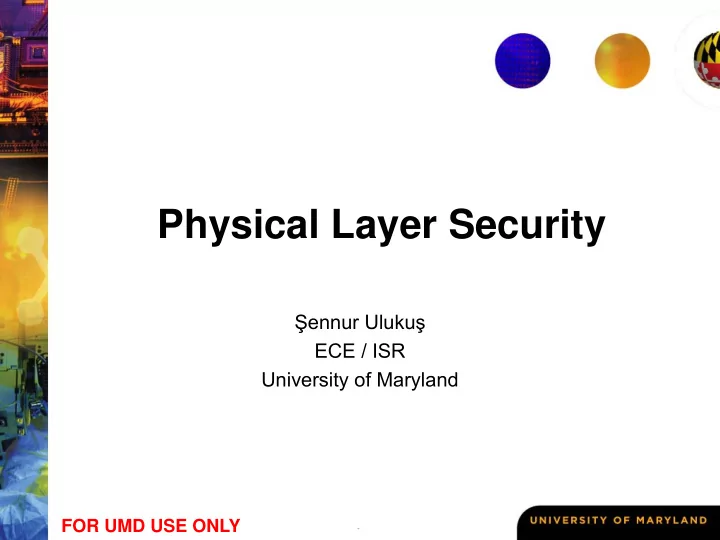

Physical Layer Security Ş ennur Uluku ş ECE / ISR University of Maryland FOR UMD USE ONLY
Security in Wireless Systems Inherent openness in the wireless communications channel: eavesdropping and jamming attacks B A E FOR UMD USE ONLY
Security in Wireless Systems Inherent openness in the wireless communications channel: eavesdropping and jamming attacks You AT&T FOR UMD USE ONLY
Security in Wireless Systems Inherent openness in the wireless communications channel: eavesdropping and jamming attacks You Your WiFi Your neighbor FOR UMD USE ONLY
Security in Wireless Systems Inherent openness in the wireless communications channel: eavesdropping and jamming attacks Bob Alice Eve FOR UMD USE ONLY
What is the Physical Layer? The lowest layer of the 7-layer OSI protocol stack. The level at which bits are transmitted/received. FOR UMD USE ONLY
Countering Security Threats: Current State-of-the-Art Cryptography: � at higher layers of the protocol stack � based on limited computational power at the adversary Spread spectrum, e.g., frequency hopping and CDMA: � at the physical layer � based on limited knowledge at the adversary Physical layer security: � at the physical layer � no assumption on adversary’s computational power � no assumption on adversary’s available information � provable and quantifiable (in bits/sec/hertz) � implementable using signal proc, comm and coding techniques FOR UMD USE ONLY
Wireless Wiretap Channel Y C X W B A ( | ) H W Z Z E = • Perfect secrecy: ( | ) ( ) H W Z H W = − • Perfect secrecy capacity: max ( ; ) ( ; ) C I X Y I X Z = − • For certain channels (but not always): C C C B E FOR UMD USE ONLY
Main Tools: Stochastic Encoding FOR UMD USE ONLY
Main Tools: Channel Pre-fixing Y B U X A Z E = − • Perfect secrecy capacity: max ( ; ) ( ; ) C I U Y I U Z FOR UMD USE ONLY
Simple Illustrative Example: Stochastic Encoding Bob has a better (less noisy) channel than Eve. B A E FOR UMD USE ONLY
Eve’s noise Bob’s noise Bob’s constellation Eve’s constellation C = = C = = log 64 6 b/s log 16 4 b/s 2 2 B E = − = 2 b/s C C C s B E
Divide Bob’s constellation into 4 subsets. Message 1 Message 2 Message 3 Message 4
All red stars denote the same message. Pick one randomly. Message 1 Message 2 Message 3 Message 4
Bob can decode the message reliably. Message 1 Message 2 Message 3 Message 4
For Eve, all 4 messages are equally-likely. Message 1 Message 2 Message 3 Message 4
Caveat: Need Channel Advantage B B A A E E positive secure capacity zero secure capacity FOR UMD USE ONLY
Two Recurring Themes: 1) Creating advantage for the good guys: � computational advantage (crypto) � knowledge advantage (spread spectrum) � channel advantage (physical layer security) 2) Exhausting the capabilities of the bad guys: � exhausting computational power (crypto) � exhausting searching power (spread spectrum) � exhausting decoding capability (physical layer security) FOR UMD USE ONLY
Obvious Applications with Natural Channel Advantage: 1) Near Field Communications 2) Medical Communications 3) Military/Civilian Green Zones FOR UMD USE ONLY
Creating Channel Advantage Exploiting channel variations (fading) Opportunistic transmissions Y X B A Z E FOR UMD USE ONLY
Creating Channel Advantage Use of multiple antennas Spatial diversity Y X B A Z E FOR UMD USE ONLY
Cooperation for Security Cooperation using (or without using) overheard signals. A C B E FOR UMD USE ONLY
Secure Broadcasting Secure broadcasting to multiple end-users in the presence of one or more adversarial nodes. B C A D E FOR UMD USE ONLY
Varying Security Clearance Levels Both B and C are friendly nodes, but they have different security clearances. We can send secure information to B (un-decodable by C), and visa versa. B A C FOR UMD USE ONLY
Untrusted (but Friendly) Relays Nodes B and C relay information without being able to decode its content. A B D C FOR UMD USE ONLY
Conclusions Physical-layer security is powerful: � no limitation on adversary’s computation power or available information � provable, quantifiable (bits/sec/hertz) and implementable Many open problems: � explicit code constructions � implementing in the existing infrastructure � better modeling adversary – e.g., active adversaries � robust modeling of adversary – e.g., no CSI � combining with cryptography � … Contact me with questions/comments/ideas: Sennur Ulukus ulukus@umd.edu http://www.ece.umd.edu/~ulukus FOR UMD USE ONLY
Recommend
More recommend